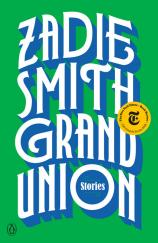Grand Union: Stories
Review
Grand Union: Stories
Zadie Smith’s first collection of short stories, GRAND UNION, will catch readers unaware as we try to pinpoint recognizable times, places and events. We look for landmarks of a society we know, or we believe we once knew, to help ground the stories and, of course, ourselves. In these 19 pieces, Smith opens up perspectives and situations that are at once certainly believable and yet so out of the ordinary that they remain unbelievable. It’s okay to become a bit lightheaded; I feel that is her intention.
Smith’s use of a small fragment can build an entire history for her characters. In “Just Right,” a young boy is described as having a pale but not unbeautiful face, a lot of dark hair “cut into a pair of slightly ludicrous curtains on either side of his narrow face.” His conversation with his teacher is cut short as he, “finely attuned to the moment when people grew bored of him,” picks up his backpack and leaves. In just a few words we see his childhood, his intelligence and the indifference of adults in his life.
"Enjoy the freshness of language, enjoy the characters who are sometimes honest and often curious, and enjoy the spaciousness of time and place."
Later in the story, he is terrified that a classmate might go to the puppet theater where he performs and that he would be found out. He tries to talk her out of going, exaggerating the admission price, but still gripped “by the horrible confirmation of a private fear --- that all roads led back to his mother.” After the puppet show and the possibility of a friendship with the girl is smashed, his mother places a ridiculous Wee Willie Winkie nightcap on his head. “People find their natural level,” she says. “You’ll see when you’re older.” Her assurances are just as hollow as we knew they would be.
In several stories, the final sentences are exceedingly harsh, laying waste to any possibility for hope. “The Dialectic” is just four pages long, beginning with a testy conversation between a mother, who wants to be on “good terms” with all animals, and her daughter, who sees through the hypocrisy of saying that and eating a chicken wing. At the same moment. The story reveals the mother’s anger at abandonment by the child’s father, and she wishes only the worst life for him in America. Finally, she hides the remains of the barbequed wing in the sand. She reflects on little chicks, perhaps millions of them, passing down an assembly line, while the chicken sexers turn them over and “sweep all the males into huge grinding vats where they are minced alive.” A life of smothering poverty in a large American city sounds easy.
The final story, “Grand Union,” leads a young woman to her dead mother, still looking fantastic, and takes us on a stream-of-consciousness journey to the Grand Union Canal, possibly a river of milk. Or it may be what all daughters are looking for, even though the generations of mothers and their mothers are disconnected, so very disconnected.
Enjoy the freshness of language, enjoy the characters who are sometimes honest and often curious, and enjoy the spaciousness of time and place. In GRAND UNION, Zadie Smith asks for our suspension of disbelief, and we must give it.
Reviewed by Jane Krebs on October 16, 2019
Grand Union: Stories
- Publication Date: October 6, 2020
- Genres: Fiction, Short Stories, Women's Fiction
- Paperback: 256 pages
- Publisher: Penguin Books
- ISBN-10: 0525559019
- ISBN-13: 9780525559016




